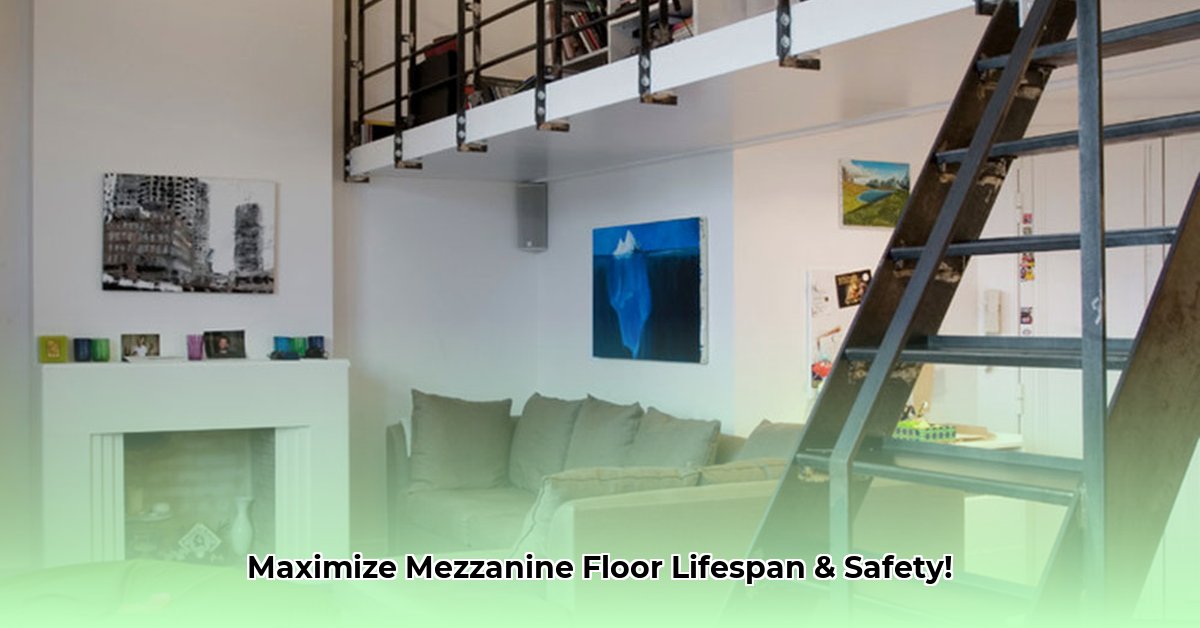Mezzanine floors are valuable for maximizing space in industrial and commercial settings, but they require consistent care to ensure safety and longevity. Neglecting routine maintenance can lead to costly repairs, accidents, and disruptions to your business operations. This comprehensive guide provides actionable strategies for maintaining your mezzanine floor, from identifying potential issues early to performing necessary cleaning and repairs, and ensuring full safety and regulatory compliance. For more detailed safety regulations, see this helpful guide on mezzanine safety. Let’s ensure your mezzanine floor remains a strong and safe asset.
Proactive Mezzanine Floor Care: Building a Foundation of Safety and Savings
Maintaining your mezzanine floor proactively ensures not only safety but also generates significant cost savings over time. Regular inspections and preventive maintenance strategies are crucial to protecting your investment and preventing disruptions to your workflow. View your mezzanine as a critical component of your business infrastructure—neglect can lead to substantial repair expenses and potential accidents that impact productivity and employee well-being. This guide provides comprehensive maintenance strategies to keep your mezzanine in optimal condition, preventing costly disruptions and ensuring a safe and efficient workspace.
Regular Inspections: Early Detection for Long-Term Savings
Regular inspections are your first line of defense against escalating problems that could compromise the integrity of your mezzanine floor. Like a regular checkup for your car, a thorough mezzanine floor inspection identifies minor issues before they evolve into more significant and expensive problems. By performing a quick visual check each month, supplemented by a yearly professional inspection, you establish a proactive approach to preventive care, ensuring the long-term health and safety of your mezzanine system.
Think of the monthly inspection as a “walkaround”—a simple yet effective visual assessment you can easily perform independently. Here’s what to examine:
- Floor Assessment: Walk the entire floor thoroughly, paying close attention to any creaks, wobbles, or other unusual noises. Evaluate the overall structural stability. Does anything feel unstable or give way slightly underfoot? Trusting your intuition can often lead to the early detection of a developing issue.
- Railings and Handrails: Carefully confirm that all railings and handrails are securely fastened and free from damage. These serve as critical safety components, preventing falls and ensuring the well-being of personnel. Look for loose screws, cracks, or sections that have become unstable. Immediate attention to these issues is paramount to maintaining a safe working environment.
- Fasteners and Bolts: Conduct a systematic inspection of all visible bolts and screws, checking for any signs of looseness or corrosion. Tightening loose fasteners promptly can resolve minor issues before they escalate into more significant structural problems.
- Floor Examination: Closely examine the flooring surface for any signs of cracks, holes, or excessive wear. Pay particular attention to areas with high foot traffic or heavy equipment use, as these are more likely to exhibit signs of wear and potential damage.
- Weight Distribution Evaluation: Periodically verify that weight is being distributed evenly across the mezzanine floor to prevent localized stress and potential structural issues. Consider how weight management impacts the overall stability and load-bearing capacity of the system.
Identifying and addressing minor issues early on can prevent the need for extensive repairs, minimize workplace accidents, and improve the overall safety and security of your facility.
Yearly Professional Inspection: A Thorough and Expert Assessment
While monthly visual check-ups are a valuable component of a proactive maintenance plan, the annual professional inspection remains essential for ensuring the long-term health and safety of your mezzanine floor. A qualified professional specializing in mezzanine structures can identify hidden issues, assess the structural integrity of the system, and detect any underlying weaknesses that might be missed during a routine visual inspection. This comprehensive health check provides valuable insights and peace of mind, helping to ensure the long-term reliability and safety of your mezzanine system. Investing in expert assessment and maintenance can yield substantial returns over time by preventing costly emergencies and ensuring structural longevity. According to a recent industry report, proactive inspections can reduce overall repair costs by as much as 30%.
Cleaning and Maintenance: Essential Strategies for Longevity and Safety
Cleaning your mezzanine floor regularly not only protects its structural integrity but also helps you spot potential issues that could compromise its safety and performance. Routine cleaning prevents the buildup of dust, dirt, and debris, which can cause surface damage, accelerate wear, and potentially conceal underlying problems like corrosion or cracks. Removing these contaminants regularly contributes to the longevity and overall safety of your system.
Here’s a streamlined and effective cleaning approach:
- Regular Cleaning: Sweep or vacuum the floor regularly to remove loose dirt, dust, and debris, paying particular attention to areas with high foot traffic or where materials are frequently handled.
- Appropriate Cleaning Solutions: Always use cleaning solutions specifically designed for your flooring material. Harsh chemicals or abrasive cleaners can cause irreversible damage, compromising the integrity and appearance of the surface. Consult the manufacturer’s recommendations for approved cleaning products and methods.
- Immediate Spill Response: Clean up any spills immediately to prevent staining, surface damage, and potential slip hazards. Taking prompt action to contain and remove spills is critical to maintaining a safe and clean working environment.
- Periodic Deep Cleaning: Schedule a professional deep cleaning service periodically, perhaps annually or biannually, to thoroughly clean and revitalize the flooring surface. This can help remove stubborn stains, embedded dirt, and other contaminants that routine cleaning may not address effectively.
Always match the cleaning method to the specific flooring material of your mezzanine, selecting gentler treatments over harsh approaches whenever possible. It is important to carefully review the manufacturer’s recommended cleaning strategy to preserve the system’s integrity and prevent any unintended damage.
Proactive Maintenance: Preventing Damage Before It Occurs
Preventive maintenance, much like insurance, provides a critical layer of protection against potentially large and unexpected expenses down the road. Proactive measures minimize potential damage to your mezzanine floor, going beyond simple cleaning and routine maintenance to address underlying issues and prevent future problems. According to industry data, implementing a comprehensive preventive maintenance program can reduce overall repair costs by as much as 25%.
Here are some key preventive maintenance strategies to consider:
- Protective Coatings: Applying protective coatings, such as rust inhibitors, sealants, or epoxy coatings, can significantly extend the lifespan of your mezzanine floor by shielding it from moisture, corrosion, and impact damage.
- Rust Prevention: Regularly inspect steel components for any signs of rust or corrosion, particularly in areas exposed to moisture or humidity. Treat any rust immediately with appropriate rust converters or inhibitors to prevent further damage and weakening of the metal.
- Load Management: Implement strict load management procedures to ensure that weight is distributed evenly across the mezzanine floor, preventing localized stress and potential floor failure. Clearly mark weight limits for different areas of the floor and train employees on proper loading techniques.
Repair Procedures: Addressing Mezzanine Damage in a Timely Fashion
Addressing minor damage promptly can often be handled as DIY projects, saving both time and money. However, when significant damage occurs, it is always best to contact qualified professionals with experience in mezzanine structure repair. Attempting unsafe or improper repairs can risk further structural damage and compromise the safety of the entire system.
Here are some examples of common repair procedures:
- Small Cracks: Use patching compounds specifically designed for the flooring material to repair small cracks or surface imperfections. Follow the manufacturer’s instructions carefully for optimal results and long-lasting repairs.
- Fasteners: Tighten any loose fasteners promptly to prevent larger issues from developing. Replace damaged or corroded fasteners with high-quality replacements of the same type and size.
- Flooring Damage: Replace sections of flooring that show severe damage, such as large cracks, holes, or delamination, to maintain the structural integrity and safety of the mezzanine floor. Use replacement materials that are compatible with the existing flooring and meet all applicable safety standards.
For extensive damage, structural issues, or repairs that you are unsure about, always call qualified professionals with expertise in mezzanine floor repair. Prioritize safety above all else and never attempt repairs that exceed your capabilities or knowledge.
Adhering to Safety Regulations: Essential for Compliance and Well-being
Safety regulations for mezzanine floors can vary significantly by location, industry, and the specific use of the structure. It is your responsibility as a business owner or facility manager to be fully aware of and comply with all applicable regulations at the local, state, and federal levels. Strict compliance is crucial not only for legal reasons but also for ensuring the safety and well-being of your employees and visitors. Consult with local authorities, building inspectors, or safety consultants to clarify any ambiguities and ensure full compliance.
Troubleshooting Common Issues
Here is a helpful troubleshooting guide for addressing common issues that may arise with your mezzanine floor:
| Problem | Possible Cause(s) | Solution |
|---|---|---|
| Sagging floor | Overload, structural damage, weak supports, material degradation | Immediate professional inspection; assess and address weight distribution; reinforce or replace damaged supports |
| Squeaking sounds | Loose fasteners, worn-out joints, friction between flooring panels | Tighten or replace fasteners; lubricate joints; professional evaluation if the problem persists |
| Visible cracks | Overloading, impact damage, material degradation, settling of the building | Repair small cracks with appropriate patching compounds; professional repair for larger cracks or structural damage assessment |
| Water damage | Leaks, spills, poor drainage, condensation | Repair leaks promptly; improve drainage; ensure adequate ventilation; professional evaluation might be necessary for structural damage assessment |
| Rust on steel support | Exposure to moisture; lack of protective coating; inadequate ventilation |
- Gray Kitchen Backsplash Ideas: Find Your Perfect Gray Tile - December 11, 2025
- Glass Wall Tiles For Bathroom: A Stylish, Durable Choice - December 10, 2025
- Glass Mosaic Kitchen Backsplash: Add Shimmer and Style - December 9, 2025









